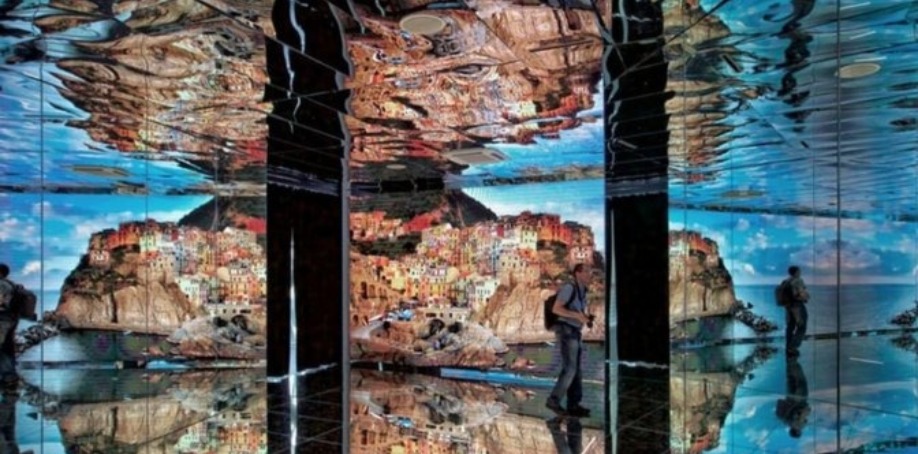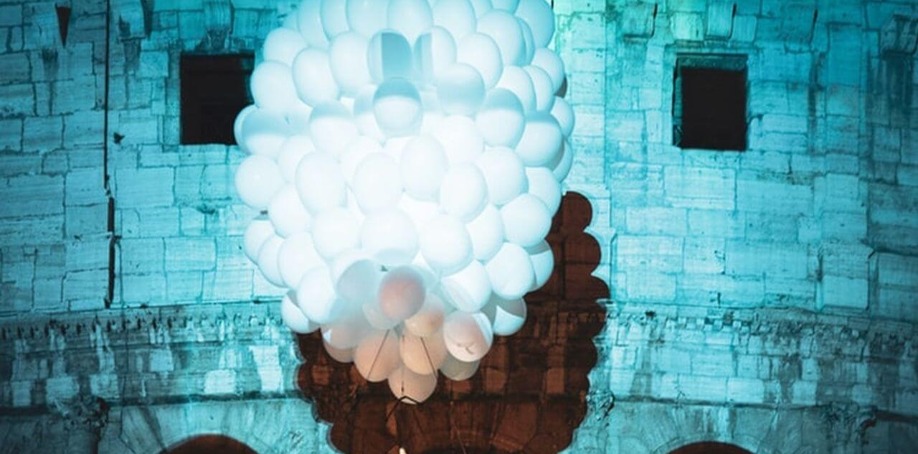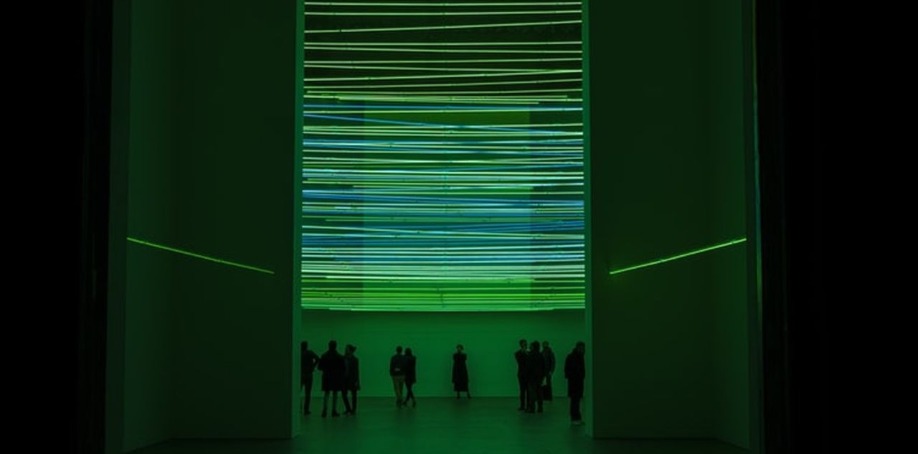
It's easy to get drawn into the spectacle of projection mapping. Colors flash, images move, jaws drop. But projection mapping can do more than immerse spectators in light and art. You can also use the medium to tell a story. We've gathered up projection mapping pro tips on storytelling from some of the best in the business. They could inspire your next project.
Identify the Core of the Story
When you begin work on a project, you might list all the bells and whistles you can share with your audience. To tell a story, however, you'll need to dig a little deeper.
Alex Reardon, design partner at Silent House Productions, works with artists on projection mapping installations for concerts and other live performances. "It’s unbelievably vital to attempt to get that nucleus. What’s it that the artist is attempting to get to?" he says.
Some clients come with requests for large screens or fire or images they've seen other performers use. Rather than using those elements automatically, he asks questions and listens to the music to guide his work.
That exact process may not be the right fit for your project. For example, some projection mapping installations are inspired by the past or you may not have an artist or performer to interview. But historical documents can help guide your choices.
When Richard Slaney, managing director at 59 Productions, worked on an installation celebrating Apollo 11, he and his team used an actual 1969 press release to influence the work. "That was basically our Bible for this project, and every time we had a question we would look back at that press release and try to work out how they were communicating it back then and follow that idea," he explains.
Stories from the past may also have special significance to your viewers. Gavin McArthur, creative director at Projection Artworks, recently worked on a live outdoor immersive experience at Museum 1939 in Gdansk, Poland, commemorating the 80th anniversary of World War II.
"World War II represents a significant era in Poland’s history and it was of the utmost importance to deliver a show that demonstrated a respectful yet unflinching portrayal of events to inspire both native and foreign audiences to a greater appreciation of Poland’s sacrifice and unvanquished spirit," he says.
Historical research can include archival footage which might give you a sense of the events as they were unfolding as well as how contemporaries reacted. Another approach is to conduct interviews with historians.
However you proceed, developing a strong sense of both the story arc and underlying themes is critical, long before you identify the technology you'll use. Once you’ve got the story, you can map out your ideas.

Move Away from Screens
Projection mapping frees you from small phone screens and tiny tablets. Your images can float on ceilings, sail over walls, or even illuminate human bodies. With the story plot and themes identified, you can let your imagination roam free.
"Projection Mapping and 3D Video Mapping Shows offer completely new possibilities in terms of storytelling and stage usage. You don’t have to rely on fixed screens or specific areas of LED screens," explains events services provider Stefan Lohmann.
Plus, the more immersive you are, the more likely you are to solve another storytelling problem.
"Entertainment companies have to fight to make their experience captivating enough to keep audiences from reaching in their pocket, grabbing their phone and scrolling through Facebook. If there is phone usage, they want the reason to be that the experience was just so good they needed to share it with their friends, family, and followers," writes the team at audio/video company Ascend Studios.
When your viewers are looking at their phones, they're missing key parts of your story. Immersing them with images could keep them entertained, listening and learning. And projection mapping allows for almost infinite possibilities.
Tell a Story in a Small Space
Some projection mapping companies are using tabletops, plates, glasses and other staples of the dining experience to tell stories. This table mapping technology could be critical for event planners, according to Vertical Media Consulting Group founder Dave Haynes. Companies could use the same projectors and technology with each new event that comes to town.
That technology could also inspire you to tell your story in similar small spaces, rather than on a flat screen or wall.
Use a Large Space for a Big Story
Tech company Hoola created a massive dome as part of a projection mapping installation for a company event in Pakistan. The organizers wanted to both commemorate the past and celebrate what humans could achieve in the future.
"The dome was an innovative means to exhibit the great advances made in the realm of technology. It was designed to pull you in, make use of all your senses, adding another layer of depth perception to the fold," the Hoola team writes.
Building a dome isn't right for every project, of course. But this example illustrates how a story can influence the set design, as well as the projection mapping plan. Some stories demand space and awe.
Include the Architecture in the Tale
Animator Maya Dite-Shepard worked on a projection mapping project that used a tower in downtown Denver as a canvas. Telling the story of a small, athletic creature by projecting her animated short onto a 10-story building replete with windows was difficult. “The challenge on this one are all the 30 windows that can change what you project onto the surface. I was worried my character would become blurry, interrupt my story or shine through the windows,” she explained. Dite-Shepard transformed that challenge into a storytelling opportunity: “My character hides behind a window or jumps down and hides between them.”
Rather than thinking in stark terms of how your story will look on the surface of your choice, think about how the space can add to the tale you're weaving for your audience.

Add Music to Deepen the Experience
A sound engineer working on a projection mapping project can tie the audio experience to the visual one.
"For example, an orchestral crescendo or pianissimo notation is met with an immersive signification of light: blossoming starlight or a dousing of the house lights all together," writes Sarah Edmands Martin, assistant professor of graphic design at Indiana University Bloomington, when describing one of her projects.
A soundtrack can help explain the images your audience sees. You can heighten emotion with just a few notes. In some cases, you can make the theme of your story shine through.
Carl Guyenette, creative director at Ellipsis Entertainment, worked on a projection mapping piece based on the novel “War of the Worlds.” The storyline and imagery were inspired by the H.G. Wells classic. Jeff Wayne’s musical version of the story, recorded much later, was also added to the immersive experience.
"In terms of the audio, in the ‘70s the album’s revolutionary synth sounds scared people so we wanted to use these once again to make the show an exciting fright-fest,” Guyenette says.
Music isn't the only element that can heighten the imagery. You can also add in noises inspired by the figures people see in your installation. That's just what a team did for an immersive museum exhibit about dinosaurs.
"When visitors first enter Dino-Time their eyes are drawn to the skeletons but when they hear the sounds of dinosaurs they notice movement on the big backdrops as the animated prehistoric creatures emerge and roam around in the wild,” says Edwin Van Huis, general director at the Naturalis Biodiversity Center in the Netherlands.
Adding a sound cue could lead spectators around your exhibit. And the right pop of noise could help them pay attention during pivotal parts of the story.
Allow for Interactivity
Our ability to delve into interactive experiences is often limited by geography, says Ernesto Escobar, founder and CEO of social entertainment center Fanaticus in Atlanta. Unless we live near a Disney theme park or another technology hub, we may not have ready access to shows that stretch our imagination.
Projection mapping could change all that, especially if you include interactivity.
Evan Grant, founder and innovation director of creative studio and research lab Seeper, worked on a project at the Sydney Sea Life Aquarium depicting the underwater world including the marine life of a reef and waves crashing onto a beach. “The interactive sensors, software, touch screens and laser scanners allowed us to encourage guests to explore natural events and life on the reef in an immersive, theatrical and memorable way,” he says.
You could use projection mapping to show your audience what sand and surf looks like. When you add technology that allows visitors to interact meaningfully, the experience deepens. Grant achieved this effect by using “lasers to create footsteps on a bioluminescent beach shoreline, allowing guests to create patterns and splash in the bioluminescence, using projection mapping on the floor and surroundings to create a live, nighttime beach scene.”
Your audience could also help to change the way your story ends.
For example, in the installation “Le Petit Chef & Friends,” a four-course dining show created by Skullmapping, an artistic collective run by Filip Sterckx and Antoon Verbeeck, sets up a competition between several tiny, projected chefs that scamper across tables and cook meals. At the end of the meal, the chef that receives the loudest applause is rewarded with a golden chef’s hat.
“We live in an experience economy. Millennials and the younger generations are about the experience," says Steve Kopelman, CEO of Escape the Room, an entertainment game room company. Letting your spectators come into your story is one of the best ways to transform a simple tale into an unforgettable experience.
Explore Your Creativity
Projection mapping can help you tell stories that are almost impossible to share with standard forms of media.
Lysander Ashton, director at 59 Productions in London, worked on a stage adaptation of Paul Aster's novel “City of Glass.” Projection mapping allowed his team to shift between realities, just as Aster does in the book. Locations can be blurred and melded with one another. "Those were the kinds of things in the book that we really wanted to try to do with the technology,” Ashton says.
Images by: ripato, dimitry_b, michel catalisano, adityachinchure


